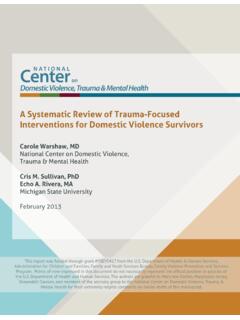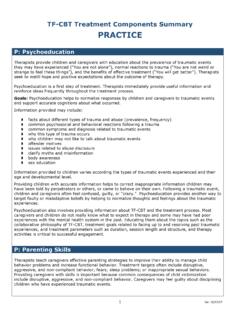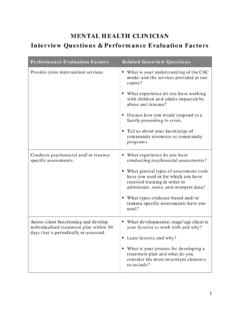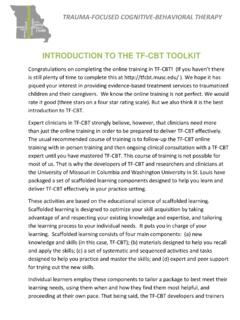Transcription of Models of Trauma Treatment - SAGE Publications Inc
1 3 Models of Trauma TreatmentA 35-year-old financial executive sought therapy after starting a new , a graduate of an Ivy League institution, described his new position as adream job with one major challenge. It involved visiting the company s branchesin other states. Michael stated that he needed therapy to help him with his fly-ing phobia. He recounted that when he was 14 years old his father was killed inan air crash. As a result, any mention of planes and flying plunged him into astate of panic. However, with therapy he was able to keep his panic under con-trol. His new employment was bringing up intense anxieties, and he was helplessin the face of further discussion with Michael, and by prioritizing his problems, the ther-apist and Michael decided to use systematic desensitization to help him with hisflying phobia.
2 Relaxation training is a first step in systematic desensitization, andMichael was already familiar with progressive muscle relaxation and deepbreathing. The next step was to help Michael create an anxiety hierarchy (pack-ing luggage, making reservations, driving to the airport, checking in, etc.). Thethird step was to have Michael engage in activities outlined in his anxiety hierar-chy, beginning with the least anxiety provoking. As soon as his distress increased,he was encouraged to stop the activity and practice phase of Treatment took several months, but Michael was able to man-age his fears and take short trips. At this point, the therapist suggested the nextphase of Treatment should focus on the issues underlying Michael s flying a stage-oriented Trauma Treatment approach, Michael was gradually ableto discuss his underlying thoughts and memories when his phobia began.
3 1/12/2007 6:28 PM Page 51reported being close to his dad and missing him terribly after he died. As theoldest of three children, he felt that he had to be stoic to support his mother andto watch over his younger siblings. He felt that he could not express his loss at thetime. Since his father s remains were never identified, he lacked closure in animportant relationship. In therapy, Michael was able to mourn his loss fully forthe first A Practical Approach to TraumaThis chapter will examine the different Models used in Trauma -focusedtherapy with adult survivors, from the cognitive-behavioral to stage-specific and self- Trauma Models .
4 Most of these Models are theoreticallyintegrative and focus on the healing that is possible in a therapeutic rela-tionship. Eye Movement Desensitization Reprocessing and psychopharma-cology are also outlined as Treatment options. Specific strategies areprovided for the beginning psychotherapist interested in working withtraumatized populations. Trauma Treatment with particular populations,such as victims of rape, domestic violence, and political Trauma , will becovered in later ApproachesMany effective therapeutic approaches and techniques have been used withtrauma survivors. Most practitioners use a combination of approachesdepending on their training and background.
5 The client s needs, however,should be the final determinant of the approach the therapist chooses to useto support recovery. When shaping interventions, the therapist must considerthe client s cultural and social background. The therapist s awareness of thesefactors inevitably affects the progress of Treatment . If practitioners are notfamiliar with the culture of the client, they should make every effort to gainthis cultural understanding. Attending professional conferences and work-shops and reading independently are ways to increase one s cultural reper-toire. However, when the cultural differences between client and therapistbecome insurmountable even after a therapist has worked at cultural under-standing, it is reasonable for the therapist to refer the client to more appro-priate services.
6 The therapeutic relationship is not the venue for negotiatingcultural addition to, and sometimes concomitant with, cultural differences is therole of empowerment and disempowerment within a therapeutic a professional with expertise, the practitioner holds a position of 1/12/2007 6:28 PM Page 52 Models of Trauma Treatment 53 The client who seeks services does not share the same privilege and may feeldisempowered as a result. If racial and cultural differences exist in the client-therapist dyad, issues of power and privilege are highlighted. Racial and cul-tural differences can significantly impact therapy, and a culturally competentpractitioner does not hesitate to raise the issues , it is important to remember that Trauma work is often integratedinto therapeutic work with clients.
7 Often, Trauma material does not surfaceuntil much later in the therapeutic process. Establishing rapport and trustshould be critical goals of any therapy, especially those that are Trauma -specific. For some practitioners, these goals remain the primary focus oftherapy with their clients for several Psychodynamic PsychotherapyBrief psychodynamic psychotherapy is an abbreviated form of psycho-dynamic therapy in which the emotional conflicts caused by the traumaticevent are the focus of Treatment , particularly as they relate to the client searly life experiences (Horowitz, 1997; Horowitz, Marmar, Krupnick,Wilner, Kaltreider, & Wallerstein, 1997; Krupnick, 2002).
8 The rationaleof brief psychodynamic psychotherapy is that a client s retelling the trau-matic event to a calm, empathetic, compassionate, and nonjudgmental ther-apist will result in greater self-esteem, more effective thinking strategies,and an increased ability to manage intense emotions successfully (Marmar,Weiss, & Pynoos, 1995). Throughout the process, the therapist helps theclient identify current life situations that trigger traumatic memories andexacerbate PTSD symptoms. In this model of Treatment , the therapistemphasizes concepts such as denial, abreaction, and catharsis (Horowitz,1997; Horowitz et al., 1997).By using a psychoanalytic approach, Burton (2004) found that clientswere able to reenact their Trauma .
9 He concluded that these reenactmentsserve several purposes. First, reenacting a Trauma is validating since itconfirms for the client that the Trauma really happened. Second, a reen-actment helps the client gain mastery over the situation that was once anexperience of helplessness. Finally, reenactments present the possibilityof reversing prior outcomes, controlling what was uncontrollable in thepast, and dealing with the Trauma in different and more hopeful TherapyCognitive-behavioral therapy (CBT) combines two very effectivekinds of psychotherapy: cognitive therapy and behavior therapy. 1/12/2007 6:28 PM Page 53therapy, based on learning theory, helps clients weaken the connectionsbetween troublesome thoughts and situations and their habitual reactionsto them.
10 Cognitive therapy teaches clients how certain thinking patternsmay be the cause of their difficulties by giving them a distorted picture andmaking them feel anxious, depressed, or angry (Beck, 1995). When com-bined into CBT, behavior therapy and cognitive therapy provide powerfultools for symptom alleviation and help clients resume normal cognitive approach has been found to be a suitable framework fortrauma therapy because traumatic experiences usually impede the emotionalprocess by conflicting with pre-existing cognitive schemas (Jaycox, Zoellner,& Foa, 2002). Cognitive dissonance, which occurs when thoughts, memories,and images of Trauma cannot be reconciled with current meaning structures,causes distress.















